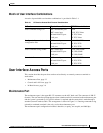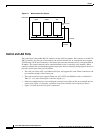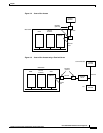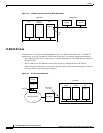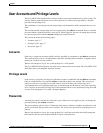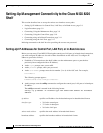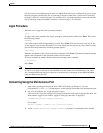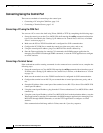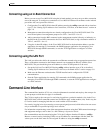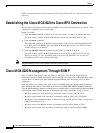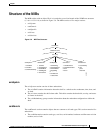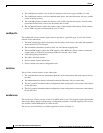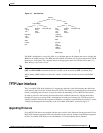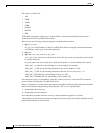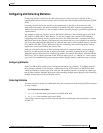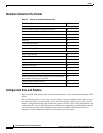
3-11
Cisco MGX 8220 Installation and Configuration
Release 5.0, Part Number 78-6430-03 Rev. D0, November 2003
Chapter
Command-Line Interface
Connecting using an In-Band Connection
Before you can access Cisco MGX 8220 using the in-band method, you must set up or add a connection
across the network. To configure a connection to Cisco MGX 8220 that will terminate on the in-band
port of the ASC card, proceed as follows:
1. Configure the Cisco MGX 8220 in-band IP address entering the cnfifip command with an interface
type 37. See “Setting-Up IP Addresses for Control Port, LAN Port, or In-Band Access” section on
page 3-8.
2. Management connection end points are already configured on the Cisco MGX 8220 shelf. The
reserved end points for management purposes are VPI = 3 and VCI = 8 to 15.
3. Add a connection from the BNI connected to the management terminal (directly or indirectly) to
the BNI in the Cisco BPX connected to the Cisco MGX 8220 shelf, using a destination address of
VPI = 3, and VCI = 8 to 15.
4. Using the in-band IP address of the Cisco MGX 8220 shelf as the destination address, start the
application for entering CLI commands, the SNMP manager application for managing Cisco
MGX 8220 through SNMP commands, or start the TFTP application to configure or collect
statistics.
Connecting using the LAN Port
The LAN port allows the shelf to be connected to an Ethernet network using an appropriate transceiver.
Thus a workstation connected to the Ethernet network can communicate directly with the Cisco
MGX 8220. The port should be given an IP address to allow TCP/IP protocols to be used.
1. Set up the LAN on Cisco MGX 8220 using cnfifip with an interface type of 26 as described
“Setting-Up IP Addresses for Control Port, LAN Port, or In-Band Access” section on page 3-8.
2. Make sure the Ethernet workstation has TCP/IP installed and is configured for TCP/IP
communication.
3. Start the Telnet application for entering CLI commands, the SNMP manager application for
managing Cisco MGX 8220 through SNMP commands, or start the TFTP application to configure
or collect statistics.
Command-Line Interface
The command-line interface (CLI) uses a simple alphanumeric terminal and employs the concept of a
system prompt to which the user types in commands.
The CLI also employs the concept of a user being logged into a particular module (slot) in the Cisco
MGX 8220 shelf, and all commands entered are assumed to apply to that module (slot). In this way the
CLI can be used for managing both the core cards and the service modules.
For security, logging in involves entering a correct preassigned password, which allows the user access
only to commands of a specified privilege level or below.
For information on performing some of the management functions using the CWM connection manager
and equipment manager, refer to the Cisco WAN Manager Operations Guide.
One command that must be entered using the CLI is the Configure Interface IP address (cnfifip).
Because a control station, including CWM, uses an IP address to communicate with the shelf, the
various ports on the shelf must first be assigned IP addresses using the cnfifip command.



